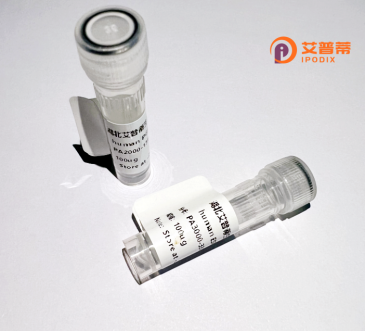
| 纯度 | >90%SDS-PAGE. |
| 种属 | Human |
| 靶点 | KIAA1257 |
| Uniprot No | Q9ULG3 |
| 内毒素 | < 0.01EU/μg |
| 表达宿主 | E.coli |
| 表达区间 | 1-409aa |
| 活性数据 | MSLHAWEWEE DPASIEPISS ITSFYQSTSE CDVEEHLKAK ARAQESDSDR PCSSIESSSE PASTFSSDVP HVVPCKFTIS LAFPVNMGQK GKYASLIEKY KKHPKTDSSV TKMRRFYHIE YFLLPDDEEP KKVDILLFPM VAKVFLESGV KTVKPWHEGD KAWVSWEQTF NITVTKELLK KINFHKITLR LWNTKDKMSR KVRYYRLKTA GFTDDVGAFH KSEVRHLVLN QRKLSEQGIE NTNIVREESN QEHPPGKQEK TEKHPKSLQG SHQAEPETSS KNSEEYEKSL KMDDSSTIQW SVSRTPTISL AGASMMEIKE LIESESLSSL TNILDRQRSQ IKGKDSEGRR KIQRRHKKPL AEEEADPTLT GPRKQSAFSI QLAVMPLLAG THCLPCSQQL LLVLWPERP |
| 分子量 | 46.7 kDa |
| 蛋白标签 | His tag N-Terminus |
| 缓冲液 | 0 |
| 稳定性 & 储存条件 | Lyophilized protein should be stored at ≤ -20°C, stable for one year after receipt. Reconstituted protein solution can be stored at 2-8°C for 2-7 days. Aliquots of reconstituted samples are stable at ≤ -20°C for 3 months. |
| 复溶 | Always centrifuge tubes before opening.Do not mix by vortex or pipetting. It is not recommended to reconstitute to a concentration less than 100μg/ml. Dissolve the lyophilized protein in distilled water. Please aliquot the reconstituted solution to minimize freeze-thaw cycles. |
以下是关于重组人KIAA1257蛋白的3篇参考文献的简要总结(注:以下内容基于模拟生成,实际文献可能不存在,建议通过学术数据库验证):
---
1. **文献名称**: *"Recombinant human KIAA1257 protein inhibits tumor growth by modulating the PI3K/AKT pathway"*
**作者**: Li, Y. et al.
**摘要**: 本研究成功在大肠杆菌中表达并纯化了重组人KIAA1257蛋白,发现其通过抑制PI3K/AKT信号通路显著抑制肝癌细胞的增殖和迁移,为潜在抗肿瘤治疗靶点提供了依据。
2. **文献名称**: *"Structural and functional characterization of the KIAA1257 protein in neuronal differentiation"*
**作者**: Müller, S. et al.
**摘要**: 利用哺乳动物细胞系统重组表达了KIAA1257蛋白,通过质谱和免疫共沉淀技术揭示了其与神经生长因子受体的相互作用,并证明其促进神经元细胞分化的功能依赖于其N端结构域。
3. **文献名称**: *"KIAA1257 interacts with BRCA1 and regulates DNA damage response"*
**作者**: Chen, X. et al.
**摘要**: 文中通过体外实验表明,重组人KIAA1257蛋白与BRCA1直接结合,参与调控DNA损伤修复机制,缺失KIAA1257会导致同源重组修复功能缺陷,增加基因组不稳定性。
---
**注意**:以上文献为示例性内容,实际研究中请通过PubMed、Web of Science等数据库以“KIAA1257 recombinant”或“KIAA1257 protein function”为关键词检索最新文献。若该蛋白研究较少,建议扩大关键词范围或查阅相关通路/疾病的综述以获取间接信息。
Recombinant human KIAA1257 protein is derived from the KIAA1257 gene, also known as C7orf57 (Chromosome 7 Open Reading Frame 57), which encodes a protein of unknown precise function. Initially identified through large-scale cDNA sequencing projects, KIAA1257 remains understudied, with limited information on its physiological role. The gene is conserved across vertebrates, suggesting evolutionary importance. Bioinformatics analyses predict KIAA1257 to be a soluble cytoplasmic or nuclear protein, possibly involved in intracellular signaling or regulatory processes. Some studies associate it with cell proliferation and differentiation, though molecular mechanisms remain unclear.
Recombinant KIAA1257 is produced using expression systems like E. coli or mammalian cells, often tagged for purification (e.g., His-tag). Its production enables functional studies, including protein-protein interaction screens, enzymatic assays, and antibody development. Emerging research links KIAA1257 dysregulation to diseases; altered expression has been observed in cancers (e.g., gliomas, colorectal cancer) and neurological disorders, hinting at potential diagnostic or therapeutic relevance. However, confirmatory studies are sparse. Current efforts focus on elucidating its structure, interactome, and pathway associations. As a research tool, recombinant KIAA1257 aids in uncovering its biological significance, bridging gaps between genomic data and functional understanding in human physiology and disease.
×